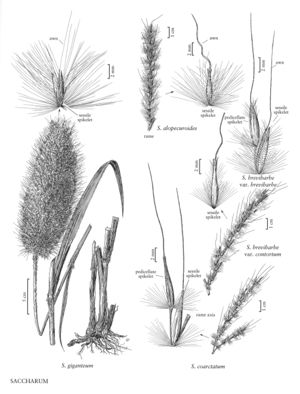Difference between revisions of "Saccharum alopecuroides"
FNA>Volume Importer |
imported>Volume Importer |
||
| (4 intermediate revisions by 2 users not shown) | |||
| Line 4: | Line 4: | ||
|publications= | |publications= | ||
|common_names=Silver plumegrass | |common_names=Silver plumegrass | ||
| + | |special_status={{Treatment/ID/Special_status | ||
| + | |code=E | ||
| + | |label=Endemic | ||
| + | }} | ||
|basionyms= | |basionyms= | ||
|synonyms={{Treatment/ID/Synonym | |synonyms={{Treatment/ID/Synonym | ||
|name=Erianthus alopecuroides | |name=Erianthus alopecuroides | ||
| − | |authority= | + | |authority= |
| + | |rank=species | ||
}} | }} | ||
|hierarchy=Poaceae;Poaceae subfam. Panicoideae;Poaceae tribe Andropogoneae;Saccharum;Saccharum alopecuroides | |hierarchy=Poaceae;Poaceae subfam. Panicoideae;Poaceae tribe Andropogoneae;Saccharum;Saccharum alopecuroides | ||
| Line 19: | Line 24: | ||
-->{{Treatment/Body | -->{{Treatment/Body | ||
| − | |distribution=Md.;N.J.;Okla.;Miss.;Tex.;La.;W.Va.;Mo.;Ohio;Ala.;D.C;Tenn.;N.C.;S.C.;Va.;Ark.;Ill.;Ga.;Ind.;Ky.;Fla. | + | |distribution=Md.;N.J.;Okla.;Miss.;Tex.;La.;W.Va.;Mo.;Ohio;Ala.;D.C.;Tenn.;N.C.;S.C.;Va.;Ark.;Ill.;Ga.;Ind.;Ky.;Fla. |
| − | |discussion=<p>Saccharum alopecuroides grows in damp woods, open areas, and field margins. It is restricted to the southeastern United States. It is rare or non-existent on the sandy coastal plain, and there are few specimens from southern Florida and the higher elevations of the Appalachian Mountains. The combination of long rhizomes, long silvery callus hairs, and spirally coiled awns distinguish S. alopecuroides from all other species in the region.</p> | + | |discussion=<p><i>Saccharum alopecuroides</i> grows in damp woods, open areas, and field margins. It is restricted to the southeastern United States. It is rare or non-existent on the sandy coastal plain, and there are few specimens from southern Florida and the higher elevations of the Appalachian Mountains. The combination of long rhizomes, long silvery callus hairs, and spirally coiled awns distinguish <i>S. alopecuroides</i> from all other species in the region.</p> |
|tables= | |tables= | ||
|references= | |references= | ||
| Line 29: | Line 34: | ||
-->{{#Taxon: | -->{{#Taxon: | ||
name=Saccharum alopecuroides | name=Saccharum alopecuroides | ||
| − | |||
|authority=(L.) Nutt. | |authority=(L.) Nutt. | ||
|rank=species | |rank=species | ||
| Line 36: | Line 40: | ||
|basionyms= | |basionyms= | ||
|family=Poaceae | |family=Poaceae | ||
| − | |illustrator=Linda A. Vorobik | + | |illustrator=Linda A. Vorobik;Hana Pazdírková |
| − | |distribution=Md.;N.J.;Okla.;Miss.;Tex.;La.;W.Va.;Mo.;Ohio;Ala.;D.C;Tenn.;N.C.;S.C.;Va.;Ark.;Ill.;Ga.;Ind.;Ky.;Fla. | + | |illustration copyright=Utah State University |
| + | |distribution=Md.;N.J.;Okla.;Miss.;Tex.;La.;W.Va.;Mo.;Ohio;Ala.;D.C.;Tenn.;N.C.;S.C.;Va.;Ark.;Ill.;Ga.;Ind.;Ky.;Fla. | ||
|reference=None | |reference=None | ||
|publication title= | |publication title= | ||
|publication year= | |publication year= | ||
| − | |special status= | + | |special status=Endemic |
| − | |source xml=https:// | + | |source xml=https://bitbucket.org/aafc-mbb/fna-data-curation/src/200273ad09963decb8fc72550212de541d86569d/coarse_grained_fna_xml/V25/V25_1502.xml |
|subfamily=Poaceae subfam. Panicoideae | |subfamily=Poaceae subfam. Panicoideae | ||
|tribe=Poaceae tribe Andropogoneae | |tribe=Poaceae tribe Andropogoneae | ||
Latest revision as of 17:57, 11 May 2021
Plants rhizomatous. Culms 1-2.5 m; nodes hairy, occasionally glabrate, hairs 7-12 mm. Sheaths mostly glabrous, ciliate distally; auricles absent; ligules 1-3 mm; blades 30-60 cm long, 14-28 mm wide, glabrous at maturity. Peduncles 40-60 cm, pilose; panicles 3-10 cm wide, oblong to lanceolate; rachises 15-34 cm, densely pilose; lowest nodes glabrous or sparsely pilose; primary branches 3-12 cm, appressed; rame internodes 3-5 mm, pilose. Sessile spikelets 6-7 mm long, 1.1-1.4 mm wide, straw-colored; callus hairs 9-14 mm, exceeding the spikelets, silvery or purple-tinged; lower glumes 5-veined, smooth; upper glumes 3-5-veined; lower lemmas 4.8-5.6 mm, without veins or 1-veined; upper lemmas 4-4.6 mm, 1-veined, bifid, teeth 1.8-2 mm, ciliate; awns 14-20 mm, flattened and spirally coiled at the base; lodicule veins not extending into hairlike projections; anthers 2. Pedicels 2.5-4 mm, pilose. Pedicellate spikelets similar to the sessile spikelets, except frequently pilose. 2n = 30.
Distribution
Md., N.J., Okla., Miss., Tex., La., W.Va., Mo., Ohio, Ala., D.C., Tenn., N.C., S.C., Va., Ark., Ill., Ga., Ind., Ky., Fla.
Discussion
Saccharum alopecuroides grows in damp woods, open areas, and field margins. It is restricted to the southeastern United States. It is rare or non-existent on the sandy coastal plain, and there are few specimens from southern Florida and the higher elevations of the Appalachian Mountains. The combination of long rhizomes, long silvery callus hairs, and spirally coiled awns distinguish S. alopecuroides from all other species in the region.
Selected References
None.
